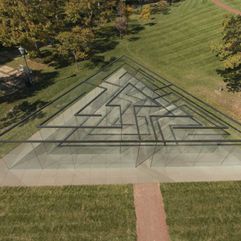

Robert Morris
1931 - 2018
Robert Morris was an American sculptor, conceptual artist and writer. He was regarded as having been one of the most prominent theorists of Minimalism along with Donald Judd, but also made important contributions to the development of performance art, land art, the Process Art movement, and installation art. Morris lived and worked in New York. In 2013 as part of the October Files, MIT Press published a volume on Morris, examining his work and influence, edited by Julia Bryan-Wilson.
Work
Initially a painter, Morris' work of the 1950s was influenced by Abstract Expressionism and particularly Jackson Pollock. While living in California, Morris also came into contact with the work of La Monte Young, John Cage, and Warner Jepson with whom he and first wife Simone Forti collaborated. The idea that art making was a record of a performance by the artist (drawn from Hans Namuth's photos of Pollock at work) in the studio led to an interest in dance and choreography. During the 1950s, Morris' furthered his interest in dance while living in San Francisco with his wife, the dancer and choreographer Simone Forti. Morris moved to New York City in 1960. In 1962 where he staged the performance Column at the Living Theater in New York based on the exploration of bodies in space in which an upright square column after a few minutes on stage falls over.
In New York City, Morris began to explore the work of Marcel Duchamp, making conceptual pieces such as Box with the Sound of its Own Making (1961) and Fountain (1963). In 1963 he had an exhibition of Minimal sculptures at the Green Gallery in New York that was written about by Donald Judd. The following year, also at Green Gallery, Morris exhibited a suite of large-scale polyhedron forms constructed from 2 x 4s and gray-painted plywood. In 1964 Morris devised and performed two celebrated performance artworks 21.3 in which he lip syncs to a reading of an essay by Erwin Panofsky and Site with Carolee Schneemann. Morris enrolled at Hunter College in New York (his masters thesis was on the work of Brâncuși) and in 1966 published a series of influential essays "Notes on Sculpture" in Artforum. He exhibited two L Beams in the seminal 1966 exhibit, "Primary Structures" at the Jewish Museum in New York.
In 1967 Morris created Steam, an early piece of Land Art. In 1969, he received a Guggenheim Fellowship for Fine Arts. By the late 1960s Morris was being featured in museum shows in America but his work and writings drew criticism from Clement Greenberg. His work became larger scale taking up the majority of the gallery space with series of modular units or piles of earth and felt. Untitled (Pink Felt) (1970), for example, is composed of dozens of sliced pink industrial felt pieces that have been dropped on the floor. In 1971 Morris designed an exhibition for the Tate Gallery that took up the whole central sculpture gallery with ramps and cubes. He published a photo of himself dressed in S&M gear in an advertisement in Artforum, similar to one by Lynda Benglis, with whom Morris had collaborated on several videos.
He created the Robert Morris Observatory in the Netherlands, a "modern Stonehenge", which identifies the solstices and the equinoxes. It is at coordinates 52°32'58"N 5°33'57"E.
During the later 1970s, Morris switched to figurative work, a move that surprised many of his supporters. Themes of the work were often fear of nuclear war.
In 2002, Morris designed a set of seventeen pale blue and beige-coloured stained-glass windows for the medieval Maguelone Cathedral, near Montpelier in France. The windows, which depict the ripples of a pebble dropped in water, were produced by Ateliers Duchemin glassmakers and placed in restored romanesque window lights around the cathedral building.
At the time of his death in late November 2018 an exhibit of Morris' recent work "Banners and Curses" was on display at the Leo Castelli Gallery in New York City. The exhibition ran through January 25, 2019. Morris attended the opening night reception for the show at the gallery.
Text courtesy of Wikipedia, 2024























